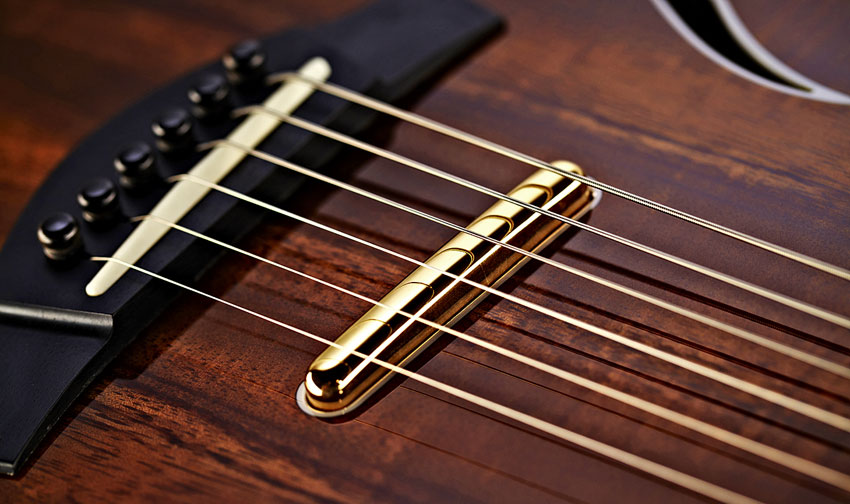MusicRadar Verdict
More electric- feeling than the T5, the T5z is still a highly visionary design for the creative player wanting to merge electric and acoustic sounds.
Pros
- +
A genuine hybrid. Great tonal range, courtesy of the EQs. Excellent build.
Cons
- -
Price.
MusicRadar's got your back

Taylor T5z Custom

Bridge

Neck

Nut
Released in 2005, the original T5 - Taylor's first 'electric' guitar, a grand auditorium-sized hollow thinline - was extremely successful. New for 2014, the T5z offers the same functionality, but with a downsized body and a more electric-like feel and setup.
"The T5z's body size is reduced from the spacious grand auditorium outline of the original to a more conventional 'electric' size"
Most obviously, the T5z's body size is reduced from the spacious grand auditorium outline of the original to a more conventional 'electric' size of 356mm (14 inches) wide by 460mm (18.1 inches) long: it's broader than a Les Paul but trimmer than an ES-335. It's not a million miles from Taylor's SolidBody SB1-S outline, with its rounded Venetian cutaway, while the bridge sits lower and is more centrally placed, on the smaller body.
The fingerboard radius of the T5z has been brought inline with the Gibson standard 12 inches instead of the original's flatter 15 inches. The bigger Taylor 'electric' fret wire - 2.74mm wide by 1.3mm high - combines to produce the most electric-like playability we've encountered from Taylor. These might seem small changes, but they have a big effect.
Feel & Sounds
Compared to our original T5, the T5z is a very different-feeling guitar. Sound-wise, too, even unplugged, things are different. That shouldn't be a surprise, as our bigger original has a solid-spruce top; the T5z Custom has a hardwood koa top and the T5z Classic, which we also tested, has a flamed maple top.
"Hardwood tops change the game," Taylor's Andy Powers tells us. "Don't forget, it's completely hollow - it's a thin acoustic guitar. A spruce top is going to have more of an acoustic response to it, because you've got the dynamic range and the quickness-of-motion of the spruce. If we use koa, maple or mahogany, you'll hear a more compressed, subdued initial attack and a little longer sustain - more of a semi-hollowbody kind of response."
"The smaller body restricts unplugged projection, though it's still more resonant, lively and louder than an unplugged ES-335"
Strapped on, the lightweight T5z is slightly neck-heavy: the original is more balanced. The smaller body restricts unplugged projection, though it's still more resonant, lively and louder than an unplugged ES-335. Our koa-topped Custom has just a little more clarity on the higher strings, compared to the slightly rounder-nosed high-string response of the maple-topped Pro.
While we've used the T5 with both electric and acoustic amps, employing a splitter to direct the signal, the T5z seems happiest into a Fender-style clean amp. Position 2 (neck humbucker) has a lovely, woody jazz voice; position 3 (bridge humbucker) has bite and depth, and hints at a Telecaster - especially with a little amp crunch. Position 4 (neck and bridge in parallel) continues the Fender-y vibe, a more mixed-pickup Tele perhaps, while position 1 (neck and bridge in series) is a little darker, more Gretsch-y.
Want all the hottest music and gear news, reviews, deals, features and more, direct to your inbox? Sign up here.
Position 1 combines the soundboard transducer with the neck humbucker and offers the maximum 'acoustic' tonality which, through our AER and Line 6 StageSource, is certainly 'modern electro', although we have electric strings, obviously, and that neck humbucker. So, even with EQ adjustment via the ES-style controls, there's still an almost hollowbody archtop element to the voice.
It is a hollowbody, of course, so the amount of volume you can achieve before feedback is less than either an ES-335 or a solidbody. That said, the T5z is more resistant to feedback than the original.
The T5, or indeed the T5z, doesn't aim to emulate a classic. And although the T5z feels and sounds more electric, the woodier tonality and shorter sustain still shouts acoustic.
It really is a hybrid. Via the highly efficient EQ, it produces older hollowbody tones, or with a treble lift, more electric, modern Americana sounds. It's a great ensemble guitar, and is ideal for tracking parts and finding space in a recording. It's a serious investment, of course - although the T5z Classic costs just £1,511 - but addictive and unique. Try one.
Dave Burrluck is one of the world’s most experienced guitar journalists, who started writing back in the '80s for International Musician and Recording World, co-founded The Guitar Magazine and has been the Gear Reviews Editor of Guitarist magazine for the past two decades. Along the way, Dave has been the sole author of The PRS Guitar Book and The Player's Guide to Guitar Maintenance as well as contributing to numerous other books on the electric guitar. Dave is an active gigging and recording musician and still finds time to make, repair and mod guitars, not least for Guitarist’s The Mod Squad.
